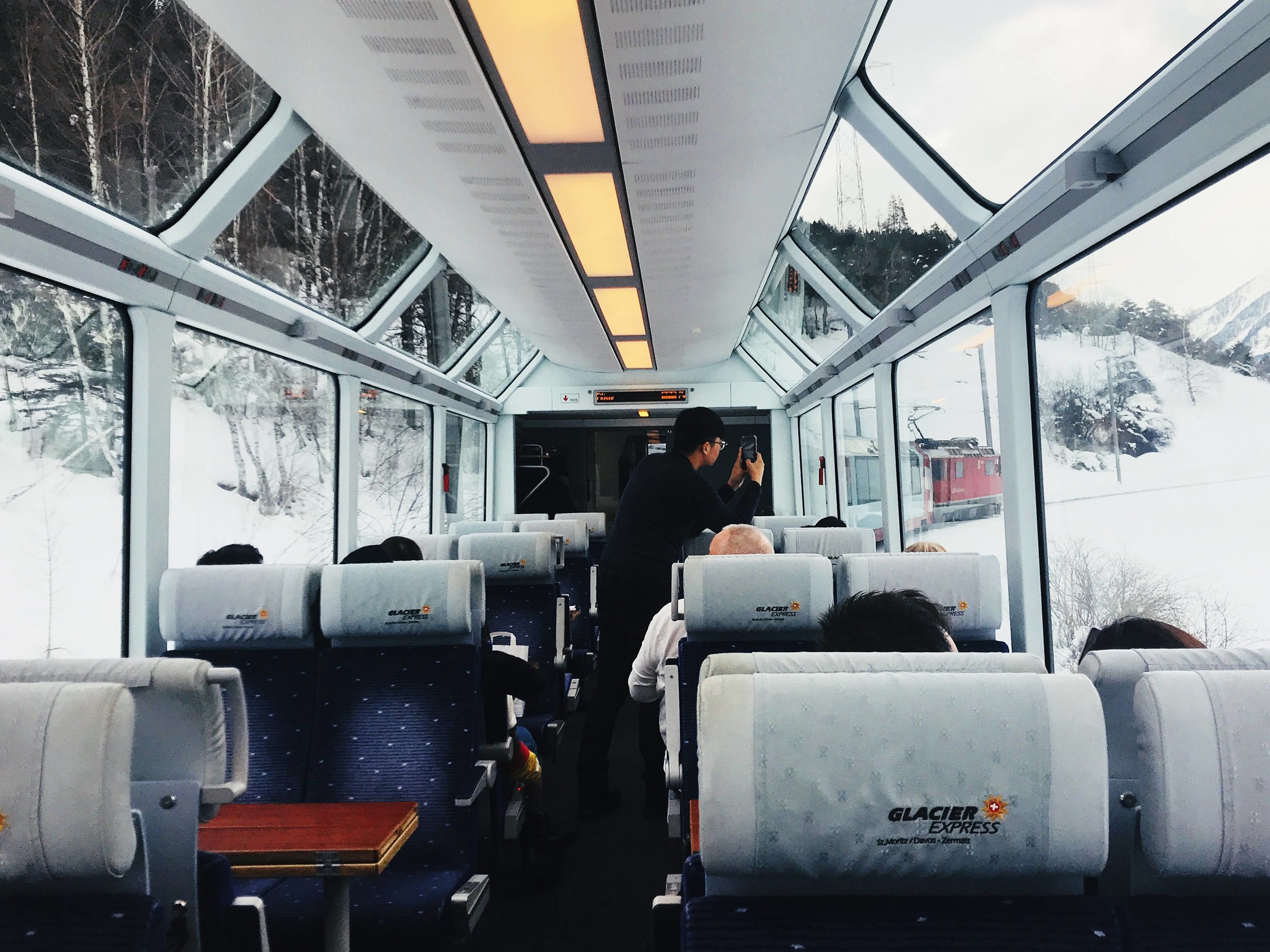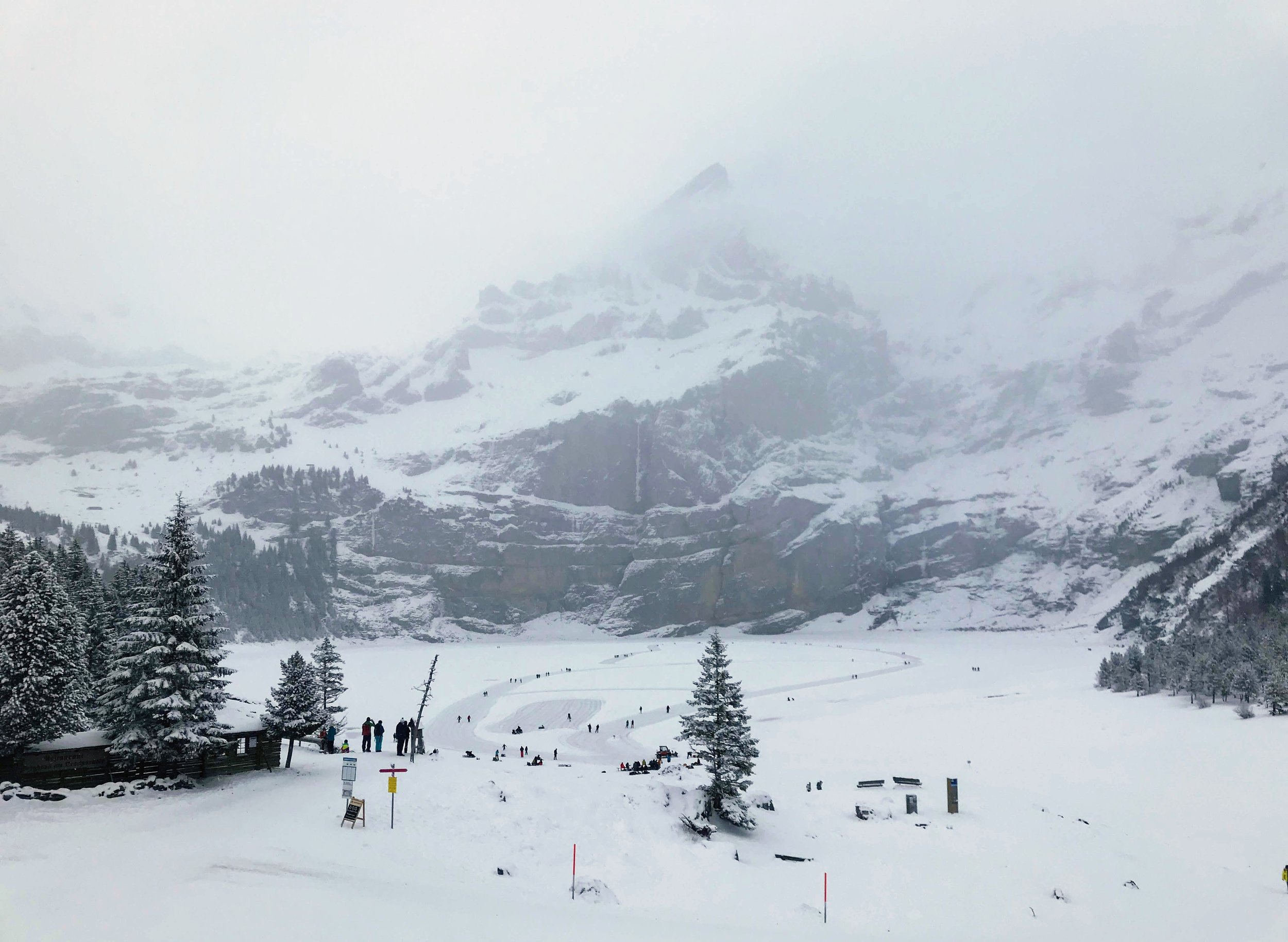One Day on the World's Slowest Fast Train: The Glacier Express
A ride on the Glacier Express is anything but fast. The 290-kilometer trip through the Swiss Alps takes over 8 hours, essentially an entire transatlantic flight within tiny landlocked Switzerland. A transatlantic flight, that is, with 291 bridge crossings, 91 tunnels, 2000+ meters of elevation gain, and (best of all) ZERO turbulence. Just the gentle rocking of the train on the tracks. My kind of flight.
As we were already in Zermatt, having spent our anniversary weekend naked spa-ing and not skiing, it made sense to take the long, long, loooong way home. The Glacier Express goes from one glitzy mountain resort town to another, gently meandering from Zermatt and the Matterhorn in the southwest to St.Moritz and the Bernina mountain range in the southeast (or vice versa). It’s a long day, to be sure, but if you are going to spend an entire day on a train, this is the train to do it in.
The Glacier Express itself looks a little bit like a spaceship inside, with dome-shaped windowed sides and a bright track light right down the middle of the ceiling (which made it nearly impossible to take photographs of the scenery outside without the glare. I guess it was their version of a watermark). Seats were cozy with ample leg room. To the Alps, and beyond!
You get a little guidebook that covers the entire route, along with headphones where you can hear snippets of information about each section of the ride. Whenever the little chime sounded, Raunaq and I scrambled to get our headphones on to listen up. It’s 70% compelling history about the scenery and route, 30% marketing push to get you to buy all sorts of Glacier Express souvenir swag (Glacier Express-branded tilting wine glass, anyone?).
Switzerland is full of places where “pictures don’t do it justice,” but on the Glacier Express, this is truly the case. Trying to take a nice photo on a moving (albeit slow-moving) train with a terrible window glare is nearly impossible, but I tried my best! I took hundreds a pictures, and most of them turned out blurry - so eventually I just put down my phone and enjoyed the ride. Pictures don’t do it justice, anyway.
It’s a trip through the lowest river gorges and the highest alpine passes, tiny mountainside hamlets and medieval Romansch castles, glaciers and quartz quarries, phantom black tunnels and blinding white landscapes, ski resorts and pristine wilderness, impressive feats of engineering and ingenuity, and Swiss history, culture and geography - all blanketed in pearly snow.
Here’s the whole trip, broken down into four easy chunks. And I’ve saved my pro tips for the very end, to make sure you read the whole thing.
Part 1 - Zermatt to Brig: Peak in the Valley
The train pulls away from Zermatt station with views of the Matterhorn, which is an impressively good way to start, and for any normal train trip would be worth the ticket itself. But this is the Glacier Express. We still had 7 hours and 45 minutes of Alps to go.
Sun was pouring in through the crystal clear panoramic windows (they literally must have been just Windexed that morning) as the Matterhorn finally disappeared from sight.
OK, I know you are probably thinking that this post is going to be incredibly repetitive, because how many ways can someone describe 8 hours of winter landscapes? So I’m playing the magical card here, just once, at the start of this journey (and post), and I promise not to use the word again. Because even though the entire trip was stunning, this section was that “winter wonderland” magical.
As the train descends into the Valais valley, you weave through forests of snow, along small little rivers and creeks, and tightly between 4000m rock walls. It felt like stumbling out of the wardrobe and into Narnia. Some of the highest peaks in the Swiss Alps are found in this region, and if I craned my neck at the right moment and angle, I could sometimes catch a glimpse of blue-white glacier at the top.
Because even though the entire trip was stunning, this section was that “winter wonderland” magical.
After crossing the Rhone, the train begins to climb, switching to cog wheels that lock into the track with a noticeable lurch. The next few sections of the Glacier Express ascend and descend thousands of meters, feats most modern trains wouldn’t be able to accomplish. The majority of the world’s railways simply rely on the friction between the tracks and the train to go up and down hills - which is powerful, but no match for a Swiss mountainside. That is a job for the cogs.
The Swiss built these cogwheel railway systems nearly 150 years ago. And because they did it right, barely anything has changed since then. If any train enthusiasts are reading this, get excited, because this trip is truly a testament to great railway engineering.
Oh, there was a family of four sitting in our same train carriage, and one of the daughters was fast asleep through this entire part of journey, her head using that perfectly clean panoramic window as a pillow. They boarded with us at Zermatt, and got off at Brig. She slept through the Glacier Express. I guess not many people can say that.
Part 2 - Brig to Andermatt: Blinded by the White
At an altitude of 2431 meters, the Furka is one of the highest Alpine passes in Switzerland, linking the canton of Valais with the canton Uri. On the Valais side, the view embraces the Aletsch Glacier, which has lost most of its spectacular size due to global warming and is now just barely visible from the train. On perfectly clear days, from Furka you can see all the way to the Matterhorn. It’s also one of the snowiest regions in Switzerland, and the reason why, until 1982, the Glacier Express only ran in the summer months. Avalanche risk was simply too prevalent in the pass to allow for safe train travel in the winter.

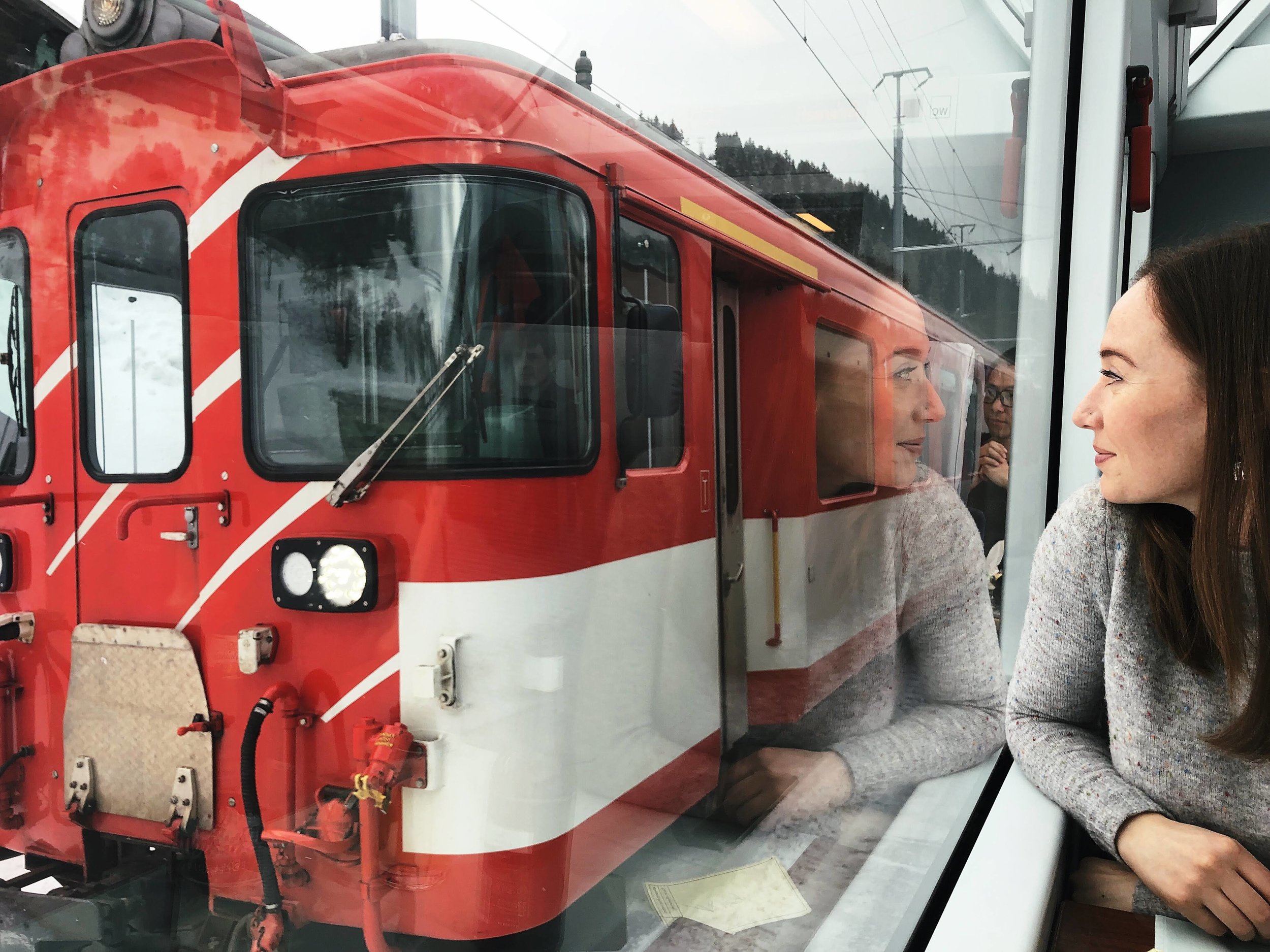
But the Swiss, when presented with a mountain of a challenge, are a bit like Tolkien’s dwarves - why go around a mountain when you could simply dig right through it? But unlike the dwarves, the Swiss know better than to delve too deep and too greedily. With a century of tunnel building to their credit, Swiss engineers saw the challenge as immense, but attainable. It took 10 years, but in 1982 the 15-kilometer Furka Tunnel, at that time the longest narrow gauge railway tunnel in the world, was complete.
Coming from the pitch-black of the tunnel, everyone was almost completely blinded by the all-white landscape. Blindsided, if you will.
We plunged into darkness as the train entered the famed tunnel, emerging on the other side of railway history. There was an audible gasp from the entire train compartment. Remember how I said this was the snowiest region in Switzerland? Coming from the pitch-black of the tunnel, everyone was almost blinded by the all-white landscape. Blindsided, if you will. Even though it was overcast, the sun was somehow still reflecting off the snow, then reflected back off the clouds and straight through the huge train windows, and it was impossible to see anything without squinting. We were above the treeline now, above it all.

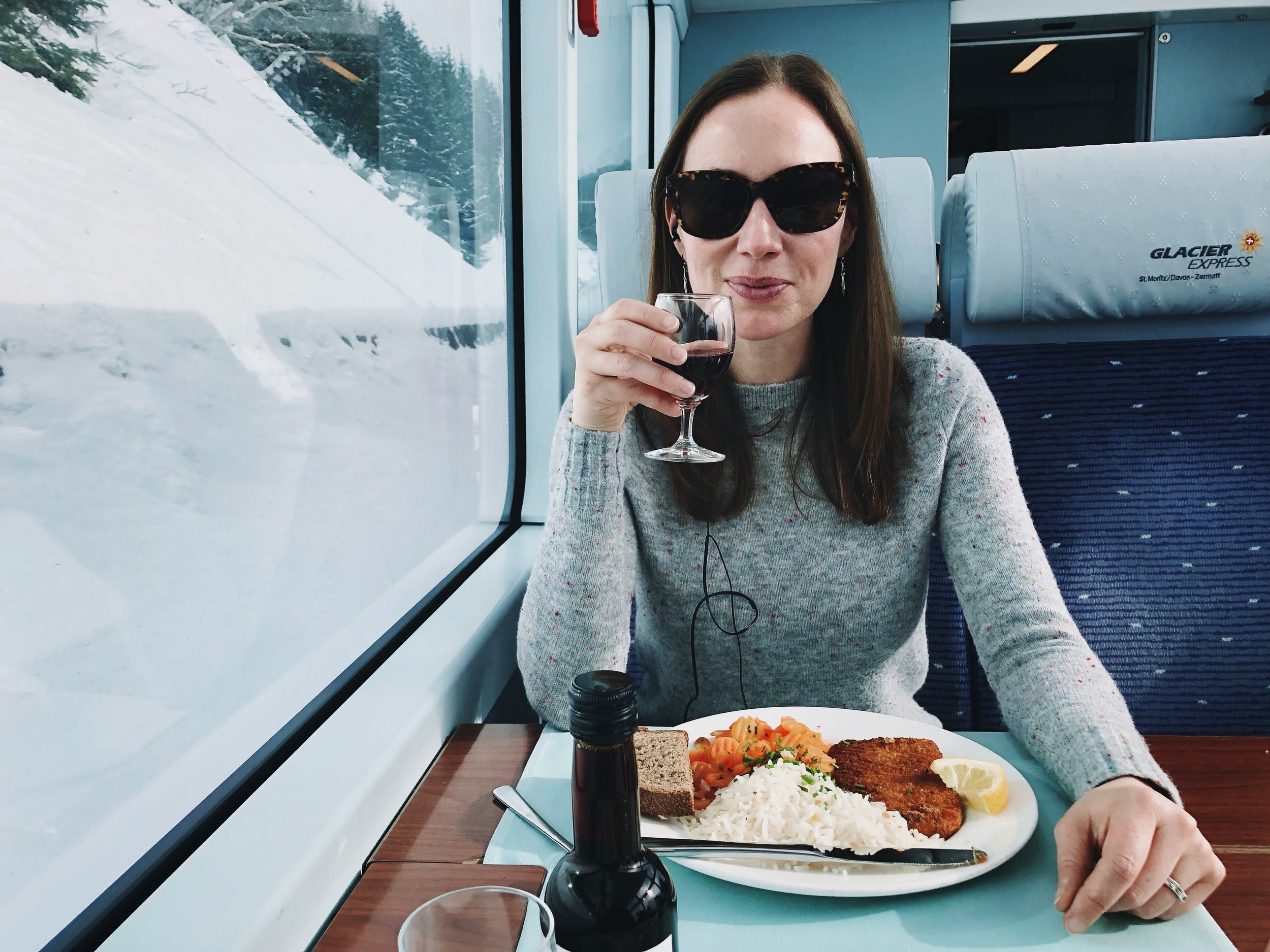
Raunaq and I donned our sunglasses, right as lunch was being served. Nothing like eating a plated meal served atop a white linen tablecloth while sipping a glass of red Rhone valley wine while leisurely gliding past snow-capped peaks while wearing sunglasses inside to make you feel like a freaking fabulous celebritae (in reality, Raunaq was giving off some strong Stevie Wonder vibes, I just looked ridiculous, but we felt pretty fancy, anyway.
Part 3 - Andermatt to Chur: Swiss Grand Canyon
The Romansch word for it is Ruinaulta, a high heap of rubble. Locals gave it this name, which is fitting since the canyon was formed by a massive rockslide of white slate. The prehistoric rockslide triggered from the retreat of the valley glacier at the end of the last ice age was the largest ever in all of the Alps range, a mountain literally tumbling to the ground. 10,000 years later, the Rhine powerfully cut through the rock, sculpting the canyon-like gorge that is there today: Ruinaulta. And the Glacier Express, after gracefully descending from Andermatt and the Oberlap pass, chugs right along it.
It’s one of the last wild places in Switzerland.
The beauty of the gorge is raw, untouched. Sharp white cliffs, milky blue waters, a grand canyon in every sense. It’s one of the last wild places in Switzerland. This is an incredible country for outdoor vistas, but one surprising thing is that it’s tough to find true “untouched” land . Switzerland is made up of a patchwork of private lands, and lots of the alpine landscape is cultivated. Even when you are up on a mountain or trekking miles through a valley, at some point you’ll be crossing through someone’s farm, village, cattle range or mountain hut. Amazingly, there is only one federal park - Swiss National Park - in this country full of superlative beauty.

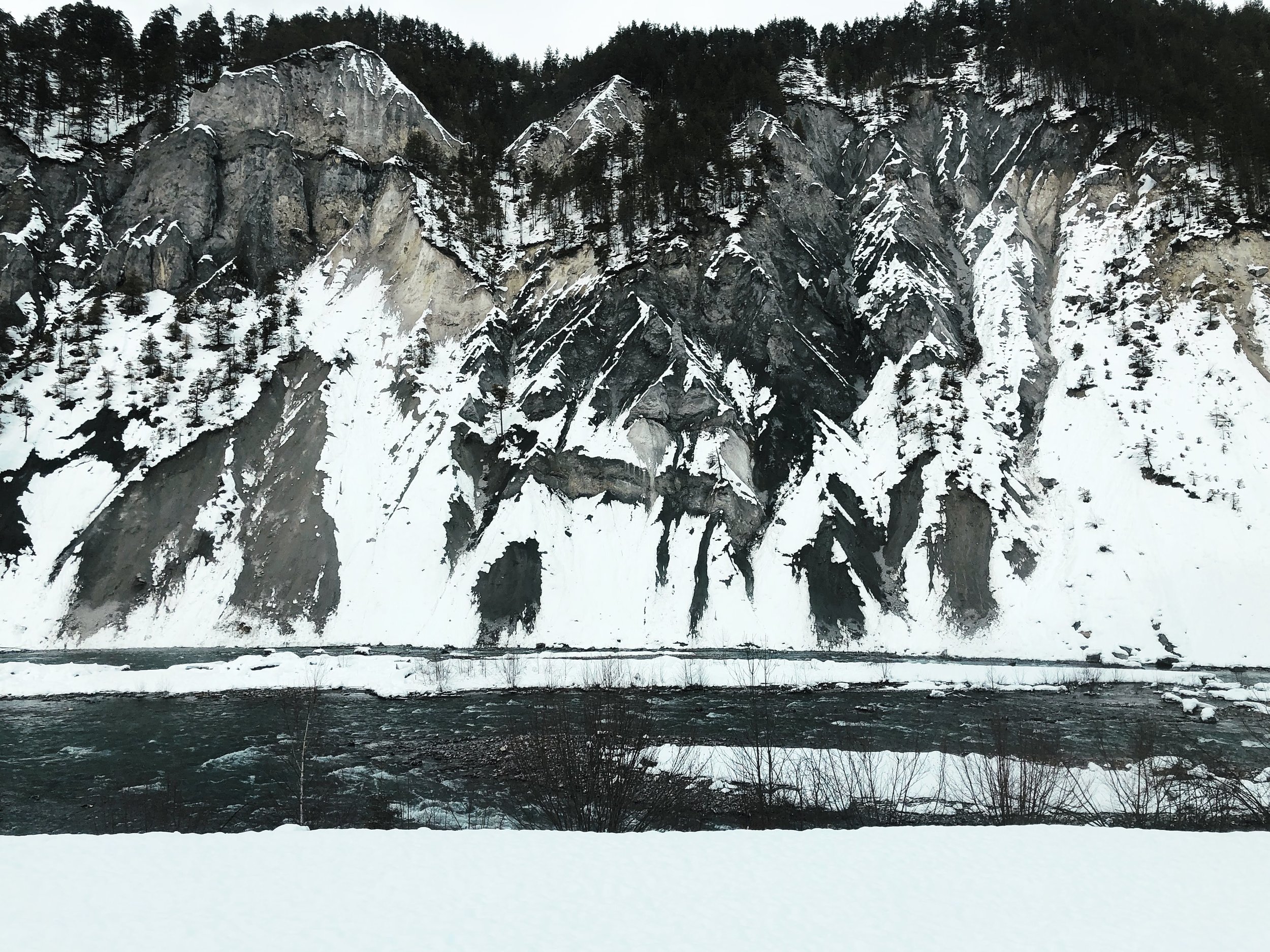
Hearing about the magic of the Rhine gorge with its mysterious lakes and rare orchids and endangered species, places uninhabited by humans and only accessible by foot or boat, compounded the stark beauty of the place. As the train followed the serpentine curves of the river, I felt lucky just seeing it from the window (and we went back a few weeks later to see if from above). For a train trip that is renowned for its peaks and glaciers, this narrow gorge valley was an unexpected highlight of the journey.
Part 4 - Chur to St. Moritz: Bridge and tunnel crowd
The train has a 20-minute break at Chur, which was a welcome opportunity to hop out for a moment, stretch the legs and get some fresh air. Another reason why this is the best transatlantic flight you will ever take. You can run around outside halfway through the trip!
Chur itself is a delightful city, the oldest in Switzerland, and according to the audio guide, has the highest concentration of bars per capita in the country. We sought to verify this fact when we ended up in Chur post-hike a few weeks later, and must have been looking in the wrong places. We ended up with Feldschlösschen roadies from the train station grocery store.
But I digress. Onward! The Glacier Express chugs past Chur and into the Domleschg valley. Strategically placed between three major Alpine passes, many castles were built along this route, making it Switzerland’s richest region for Middle Age fortresses. You can catch a glimpse of a few as you whiz by. And then, we were on the Rhaetian Railway’s Albula line, famed for its soaring viaduct bridges and helical (spiral) tunnels. Are you ready for more railway engineering feats?
A traditional tunnel burrows straight from one end of a mountain to the other. A helical tunnel, on the other hand, engulfs the entire length the locomotive, loops it around a gently ascending track inside the mountain, and emerges on the other end. The train spirals inside the mountain! The Albula line has three complete spirals, and each time you emerge you are at a higher elevation, with different views of the valley below.
In between these tunnels are the graceful arched viaducts. The most celebrated is the Landwasser Viaduct, a tightly curved, six-arch majesty that stands 60 meters above the valley river. This is the pass where everyone scrambles for their phone, pressing against the window to take the famous “blink or you’ll miss it” picture before the train flies straight into one of the many tunnels. But those few seconds are truly spectacular to see, watching the candy-apple red Glacier Express gracefully curve around the bend.
At one point, right before the Landwasser bridge, we stalled for about thirty minutes, alone on a high mountain pass. Eventually, a recording announced that there was a technical problem and the train wouldn’t be able to complete the journey. That’s not very Swiss! And then, as if nothing had happened, we started moving again. I’m still not sure if we really stalled or if someone accidentally sat on the wrong announcement button.
But you know what is Swiss? Even though we were sitting on the tracks in the middle of Upper Engadine Valley for half an hour, we still managed to arrive at our final destination of St. Moritz exactly on time.
But those few seconds are truly spectacular to see, watching the candy-apple red Glacier Express gracefully curve around the bend.
The total trip time is 8 hours, but honestly, it didn’t feel that long. I had downloaded a few podcasts and an audiobook for the ride, figuring that I could still be entertained while not missing anything out the window, but I never needed it. The only difficult part was that while the Glacier Express ended in St. Mortiz, our personal journey did not. We still needed to get home to Zurich that night, which meant another 3 hours, backtracking back to Chur and then on a (real) express train back home. That felt long.
The Extras
This trip was the furthest south and east we have been thus far in the country, traveling through parts of Switzerland we had never been to before. So many villages, valleys, and - activities! There’s skiing and snowboarding, of course, and we saw lots of both. But, there was also cross-country skiers gliding along the large swath of groomed trails in the mountain village of Goms. Off-piste snow-shoers just disappearing into the forest in Andermatt.
This is what I love most about Switzerland. That’s there’s no shortage of outdoor adventures, and all over the country, every single day, people are out doing them.
And arguably the coolest thing I had never heard of before: the 6-km Preda-Bergün toboggan run. Europe’s longest flood-lit (which means you can do this AT NIGHT) toboggan run, which hurls sledders under viaducts, around hairpin turns, and through the Albula Valley. I had my nose pressed to the window like a 5-year old watching them whip around turns.
I left the train with a scribbled list of misspelled town names and semi-cryptic descriptions like “toboggan: baller!” This is what I love most about Switzerland. That’s there’s no shortage of outdoor adventures, and all over the country, every single day, people are out doing them.
Final Thoughts
It’s hard to choose a favorite leg, because they all had something unique and spectacular to offer. The section around up around Andermatt and then down into the Rhine River Gorge, maybe? But then again, the helical tunnels near the end were so incredible. And then there was the beginning of it all, weaving through the Narnia forest after a wave goodbye from the crooked mythic Matterhorn. Don’t make me choose.
You’ll see that I kept my promise - I only used “magical” to describe the Glacier Express once. But come on. The whole thing is magical.
Travel Tips
You can book sections of the trip separately if the idea of an 8-hour train ride sounds torturous. It may be the Glacier Express, but it’s still an all-day journey, after all.
In fact, you don’t need to take the Glacier Express at all. All types of regional and express trains share the railways with the Glacier Express, so you could definitely hack your own journey if you felt up to it. But I personally think the entire experience on the Glacier Express is nicer, plus you have those amazing freshly-Windexed pano windows.
You can bring your own food or order from the on-board restaurant. Generally, Raunaq and I are huge supporters of DIY boozy picnics on public transit, but in this case, it was nice to have a fresh, plated meal. It adds a bit to the feeling that this is less about a trip from A to B and more about an experience.
There is really no “best side” to sit on. Just make sure you reserve a window seat. Depending on the leg of the journey you are on, different sides will have different views. On our trip, people got on and off at different stations, so the train was never fully packed, and we were able to switch from side to side.
Bring sunglasses! So you can feel like a super-famous celebrity and, you know, see things when you are snow blind.
Pro pro pro tip: The Glacier Express is included in the GA area, so you could buy a Super Saver Day pass and use it on the train. Then, you’d just need to pay the additional cost for the seat reservation. It’s expensive, but nowhere near as expensive as booking it all directly through the Glacier Express site.



